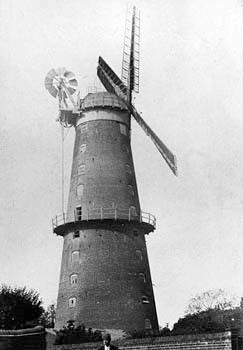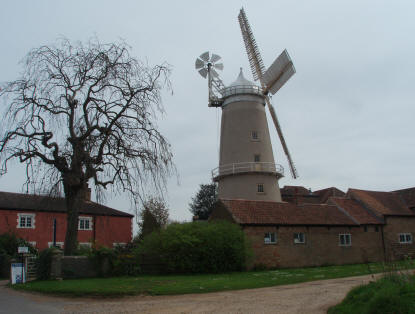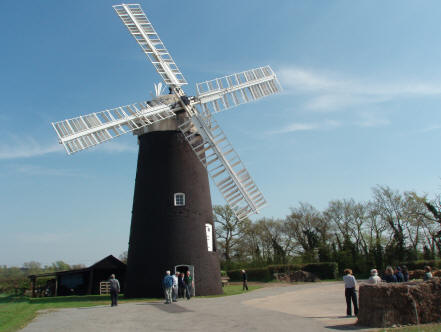|
   |
|
Page 4 |
Newsletter 125 Summer 2019 © Hampshire Mills Group |
|
Tower Flour
Robin Appel
The Origins of Tower Mills (in Norfolk)
|
This article
attempts to answer a question raised at the recent
meeting about the advent of tower mills. Nobody
seemed to be clear, and nor was I, so I have done
some research.
At the Spring meeting of HMG at Emsworth, following
a first class talk from Peter Hill on “Windmills of
the Channel Islands”, a question arose about the
advent of most of the tower mills which had been
illustrated. They all appeared to have been built
in the first quarter of the 19th century. Was this
influenced by the Corn Laws (1815-1846)? Was their
construction responding to demand from an expanding
population?
In order to try and get a view on this, it is
sensible to look at those counties where windmills
were once abundant: the eastern counties of
Suffolk, Norfolk, and Lincolnshire in particular.
These counties with their predominantly flat, wide
open landscapes, crossed by few, and slow moving
rivers, produced far more windmills than water
mills, a contrast to their near neighbouring
counties to the south and the west. I will focus on
Norfolk where all the windmills recorded are
overwhelmingly tower mills, and pertinently, mostly
constructed in the 19th century.
|
|
Tower mills were very expensive constructions, more
expensive than the average water mill. They were
mostly built of stone in the western half of the
country, and of brick in the eastern counties. The
towers varied from 20ft diameter at the base, with
walls 18ins thick, to 42ft in diameter at ground
level with walls 4ft thick. They were mostly 5
floors, but anything from 3 floors to 11 floors
(High Mill, Southtown, Great Yarmouth) according to
the records. But they were more powerful than water
mills, with more space for machinery and storage.
Norfolk corn windmills, of all structures, peaked
around 1845, numbering 435 in total, after which
there was a progressive decline down to just 100 by
1912.
|
 |
|
Concentrating on the tower mills, at the end of the
18th century there appears to have been only a
handful (about 10) in existence within the county,
the earliest being dated 1740. Coming back to the
first question raised at the Spring meeting, Harry
Apling’s book, Norfolk Corn Windmills,
published in 1984, records 99 tower mills, of which
just over half (56) were constructed between 1815
and 1846, the Corn Law years. There were fewer ‘new
builds’ in the run up to 1815, than there were
post-1846, the last construction in 1885. So the
conclusion from a simple layman like myself, has to
be, that there is no exact correlation between the
construction of tower mills and the Corn Laws,
although that fiscal legislation must have helped,
while it lasted.
The point is, as I have already highlighted, tower
mills were expensive to build, and so the investment
was safer if it was underwritten, so to speak. And
between the years 1815 and 1846, underwritten it
certainly was! The Corn Laws protected the domestic
price of wheat up to 80 shillings per quarter (never
attained in the period), the minimum price at which
imported wheat could be placed in the home market.
That was a huge price in 1815, and land owners,
farmers, and millers all prospered on the back of
this protection. To give you some perspective of
this wheat value, I was still buying English wheat
from farmers as late as early 1973, at about 80
shillings per quarter (5 quarters to the ton), or to
be more precise – £20 per tonne. The Corn Laws
were, of course, all about protecting land owners
(who dominated Parliament), albeit protecting them
at an enormous price for the working man. This
latter point would seem to answer the second
question from the Spring meeting, that of rising
demand for flour. It is unlikely that it was
exponential during the Corn Law years!
Despite a long drawn out campaign to repeal the Corn
Laws, it was the Irish Potato Famine which began in
1845, that finally drove Sir Robert Peel’s
government into over-throwing them. Then with cheap
imported wheat, from North America in particular,
combined with the new technology of roller mills
(from Hungary), new large scale mills built on the
dockside eventually spelled the demise of the small
country flour mill, wind, or otherwise. |
 |
If there is any correlation to be drawn over the
construction of tower mills, a recurring theme in
Harry Apling’s book is that it seems the majority of
those in Norfolk, at least, were constructed on the
site of a former post mill! Why? The problem of
post mills was twofold: (1) as we know from the HMG
membership, like all mills, post mills “shook
themselves to bits”, and (2) particularly in the
eastern counties, they were frequently blown over
with terminal consequences for both man and
machinery. The solution to both issues was
straight-forward: build a structure with fortress
like dimensions!
|
|
As a boy, growing up in Suffolk, one particular
tower mill in the next village, that of John
Bryant’s much photographed Pakenham Mill of 1824
(right, during an HMG visit), was a regular feature
of my life. The mill, which sits immediately behind
the farm buildings, was still regularly grinding
corn up to the mid 1960s, some of which was fed to
Mrs Bryant’s chickens which supplied the Appel
family’s (large) weekly eggs requirement – my mother
baked a lot!. Driving up to the farm when the sails
on the mill were turning was always quite
atmospheric, and an experience which even further
endeared me to embark on a career in the corn trade. |
 |
|
   |
|
|




